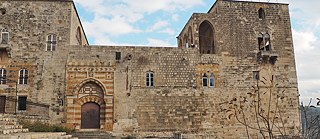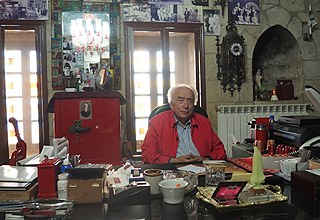Traces of Germany in Lebanon
The Baz Family – German Nobility in Lebanon

These days, only few visitors stray into the Marie Baz Wax Museum, housed in the old Fakhreddine Palace in Deir el-Qamar. The centuries-old palace houses more than 40 lifelike wax figures, spread over several storeys. These figures are representations of the most important figures in Lebanese history.
hey offer visitors a thrilling introduction to the country’s turbulent history. If a visitor shows particular interest, Samir Emile Baz invites him or her to join him for a tea. The aged head of the Baz family is still in charge of the museum, and is especially delighted when he is able to provide younger people with an understanding of Lebanese history. In Lebanese schoolbooks, the country’s history abruptly comes to a halt before the outbreak of the Civil War. The things that happened afterwards are not explained in the schools – but they certainly are in the Marie Baz Wax Museum.
Samir Baz opened the museum two decades ago, using well-known figures to make Lebanese history accessible to the country’s citizens. For half a million pounds, he had over 40 wax figures made in France, and then had them shipped to Lebanon. He converted Fakhreddine Palace, which has been in the Baz family’s possession for generations, into a spacious museum. Lifelike Druze princesses, occupiers and militia leaders all serve to bring Lebanon’s eventful history to life. Gergiz Baz, an ancestor of the museum’s founder, can also be found there, standing amidst former state presidents and patriarchs, In the 19th century, the Baz family was one of the most important and influential families in the region. Gergiz served the ruling Shihab family as an adviser, and was responsible for the education of the family’s sons. During this time, he bought Emir Ahmed Shihab’s palace in Deir el-Qamar, which is among the most magnificent palaces in the region, and which like Fakhreddine Palace is still in the possession of the Baz family. However, the family’s origins lie in a different place altogether: in Germany.

As is the case with most Lebanese families, Samir Baz’s family tree is not without its gaps. Too many of his ancestors count among the millions of Lebanese who emigrated to America, Africa, Australia and Europe in recent centuries, and who took the knowledge of their origins with them. Today they come back to visit Lebanon from all over the world, and nearly always end up in the museum director’s office, where together they attempt to reconstruct their family’s origins.
And only recently, the head of the Baz family discovered that there is still a Baz family living in Cologne. He plans to contact them, and hopes to visit them in Germany this coming year. Perhaps such a visit can close the gaps in the German/Lebanese family chronicle.